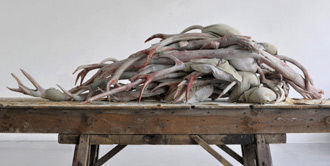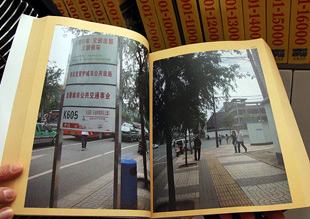la Biennale di Venezia 55th Inernational Art Exhibition


Anthony Japour (AJ) is an art collector, advisor, independent curator, and private art dealer. Japour deals in the international contemporary art movement with a focus on the Chinese Contemporary Art Movement and its relationship to the pillars of Western Contemporary Art. Since 2003, AJ has produced numerous art exhibitions and installations in Miami and South Florida through AJ Japour Gallery and now works on various art projects. AJ has served on the Fine Arts Board and the Cultural Arts Council of the City of Miami Beach.
Every two years, Venice Italy is host to the Venice Biennale lasting for six months (June through November), anchored by an international exhibition (curated this year by Massimiliano Gioni) and National Pavlions, who fund, curate and mount exhibitions of their choosing. This year, 88 countries are participating in the Venice Biennale. Ten countries are participating for the first time- among them the Holy See. Forty-seven collateral events approved by the curator of the International Exhibition are also on view. The Biennale is notably non-commercial- meaning you can’t buy anything at the exhibition in counter-distinction to an Art Fair.
Richard Vine opined in July 2013 Art in America, that based solely on numbers with nearly 350 Chinese artists, this year’s Venice Biennale could be regarded—with only slight exaggeration—as a giant survey of contemporary Chinese art with some Western work mixed in for balance. For me personally, it was heart warming that one of the Chinese Contemporary artists I have exhibited and collected, Wang Qingsong (see Social Miami column) representing China in the official China pavlion.
Berlinde de Bruyckere (b. 1964, Ghent) Belgium Pavlion
Berlinde de Bruyckere’s is a sculptor who has been hailed as a sculptor who has re-tooled the anguish and body-fixation of Francis Bacon and Alberto Giacometti. de Bruyckere lives nearby the 1492 Ghent Altarpiece by Jan van Eyck which depicts a nude Adam and Eve among the altarpiece’s 12 panels. The style of the painting was highly naturalistic and some of de Bruyckere’s sculptures have a van Eyck sensibility of plump muscular flesh. The artist has been reported to be strongly influenced by her Catholic upbringing; many of her deformed human bodies are suggestive of tortured martyrs. Financial Times writer Jackie Wullschlager has described de Bruyckere as one of the most gifted sculptors of her generation.

For the 2013 Venice Biennale, De Bruyckere has evolved from what began as initially figurative sculptural works and drawings involving contorted human bodies to hybridized sculptures of human and trees and now to her most recent sculpture for the Belgium Pavlion, Cripplewood, 2013 where she has dispensed the human body completely. The massive three-dimensional work in the Belgium Pavlion was breathtaking and installed in a dimly lit room evoking a mystical spiritualism to the work. Simultaneously haunting and sublime, Cripplewood, 2013 is a must-see for anyone going to the Venice Biennale.

Cameron Platter (b. 1978, Johannesburg) South Africa Pavlion
I first became acquainted with Cameron Platter through his art residency with a Miami non-profit, The Fountainhead, founded by local collectors and philanthropists Dan and Kathryn Mikesell. It’s one of those rare experiences for me these days where I met the artist socially before I became acquainted with the work.
As reflected in Platter’s artist statement, what he interprets as South Africa’s “shenanigans, sleaze, sweat, dirt, perversity, politics, economics and absurdity are the backdrop” for his work. Working in multiple modes of drawing, painting, sculpture, photography, and video, the artist, despite his reticent countenance has quite a bit to say through his works of art. Two concepts figure prominently in his work. As it turns out both while seemingly disconnected appeared simultaneously the first is that of chicken, namely fast-food chicken of the Kentucky Fried Chicken variety that serves as a metaphor for what links socially disparate groups in South Africa; the second is sex-related advertisements which are apparently widespread across South Africa and serve as a melting pot for the social classes.
At Frieze-New York Art Fair this past May 2013, Platter was selected by the jury to have a solo booth at the Fair and was represented by the South African Whatiftheworld Gallery. The booth installation included one of his large-scale sculptures from the Liquid Amber tree in South Africa, entitled Tell Me Everything, 2013 which is text from adult want ad— one wonders whether these works draw from actual ads or whether they’re made up in the artist’s mind. In either case, they are amusing.
For the Venice Biennale, a large-scale drawing, which mimics a linocut, is an appropriation of the work The Good Shepard by the Namibian-born, Rorkes Drift trained artist, John Mufangejo. One level this work is part of series of three studies for his video work Black Up That White Ass II. Another of the works from this series was acquired by MoMA (NY) for their permanent collection, as well as being shown on the show Impressions from South Africa, 1965 to Now at that museum. Platter’s re-interpretation of Muafangeljo’s work has to do with the period of post apartheid art where Platter is concerned about documenting his contemporary reality layered on Muafangelo’s work.
Platter graduated with a BFA in painting from the Michaelis School of Fine Art, Cape Town, in 2001. Recent exhibitions include Museum of Modern Art, New York, The Centre Georges Pompidou, Paris and Haus Der Kultur, Berlin.


Wang Du (b. 1956 Wuhan) Cuba Pavlion
Wang Du is part of the Chinese-diaspora living and working in France since 1990 and I’ve been following his work for many years. While much has been made in the press about Ai Wei Wei’s run-in with the Chinese penal system, long before, Wang Du, who had his first exhibition in 1976 the year Mao Zedong died, was warned in 1987 by the Chinese authorities to stop organizing monthly discussions on a variety of intellectual topics. Later in 1989, Wang was imprisoned for nine months for speaking out against corruption. After his release from prison, he exiled himself to Paris.


Wang Du’s most compelling works are those in which he interrogates the issue of artificial mind control used by the media and it’s affect on the collective public consciousness; namely, the manipulation of our minds through subliminal messaging imposed by what he perceives as the global industrial media complex. A number of years ago, I recall sitting in the Portman Hotel in Shanghai reading the local Chinese Newspaper when a very intelligent-looking person came up to me and asked “why are you reading the newspaper- after all its all manufactured”. While I must have looked incredulous, and without my responding he said “and so what if it is, so is yours” and he walked away.
Ironically, Wang Du’s work was included in Cuba Pavlion for the 2013 Venice Biennale with a work entitled, Yellow Pages, 2009- some 30,000 images of pretty much nothing but evoking the Orwellian idea that we are all under surveillance at all times. Of greater irony is contemporary society’s voluntary embrace of Facebook’s catalogue of our every move.
Wang Du was classically trained at the Guangzhou Institute of the Fine Arts of his solo exhibitions include Wang Du at Baltic, The Centre for Contemporary, Gateshead; The Time Tunnel at Palais de Tokyo, Paris and Disposable Consume Reality at Rodin Museum, Seoul. His works have also been included in exhibitions at the Dublin Contemporary 2011, Dublin; The Power of Art, Grand Palais, Paris; Be Biennale de Lyon, Lyon, France, 48th Venice Biennale, and more recently a return to China in the exhibition Electric Fields: Surrealism and Beyond- masterpieces from the Centre Pompidou Collection, Power Station of Art, Shanghai.


Aaron Glickman is a creator/producer native to Miami. He has worked in South Florida media for the past 15 years documenting a regional transformation predicated on art and design. His digital media platform, www.Current.Miami, tells hyper-local stories through the use of video.
From 2007 to 2016, Aaron was the publisher of SocialMiami.com, a society-driven digital media platform. During that period, Aaron created content-driven strategies with many of the region’s most prestigious brands and institutions. He also served on boards and committees for several non-profits.
In 2017, Aaron produced and directed the feature-length documentary Miami Basel: Art’s Winter Playground. The film tells the story of Art Basel’s influence on Miami. Its world premiere in 2019 at the Miami Film Festival.
Prior to working in media, Aaron was a union stage actor. He studied Shakespeare in London and was a six-year member of Theatricum Botanicum, a classical theater company located in Topanga Canyon, California. In 2016, Aaron returned to the stage to tackle the role of Richard Sherman in “The Seven Year Itch” and is currently doing voice-over work for NBC.


